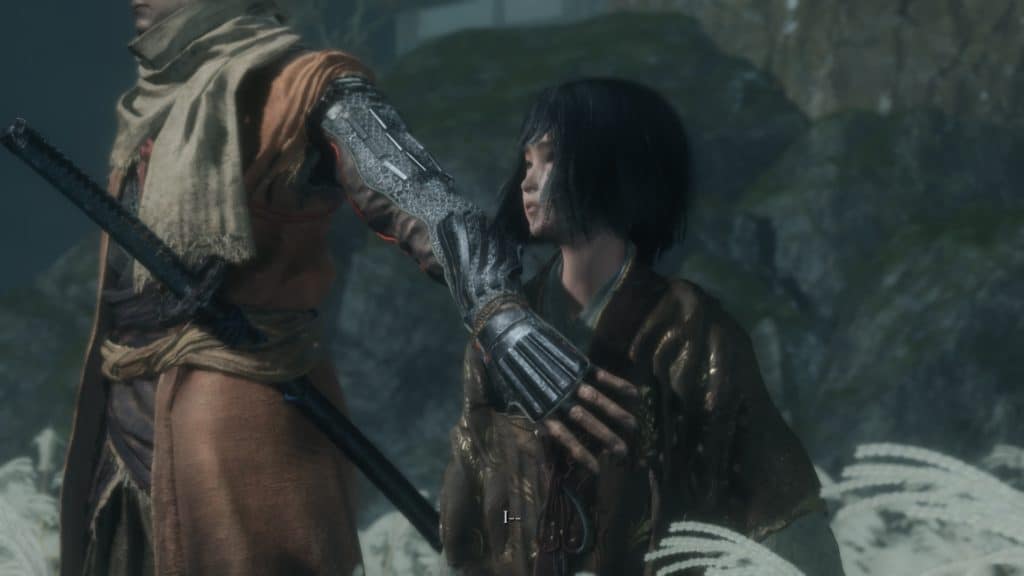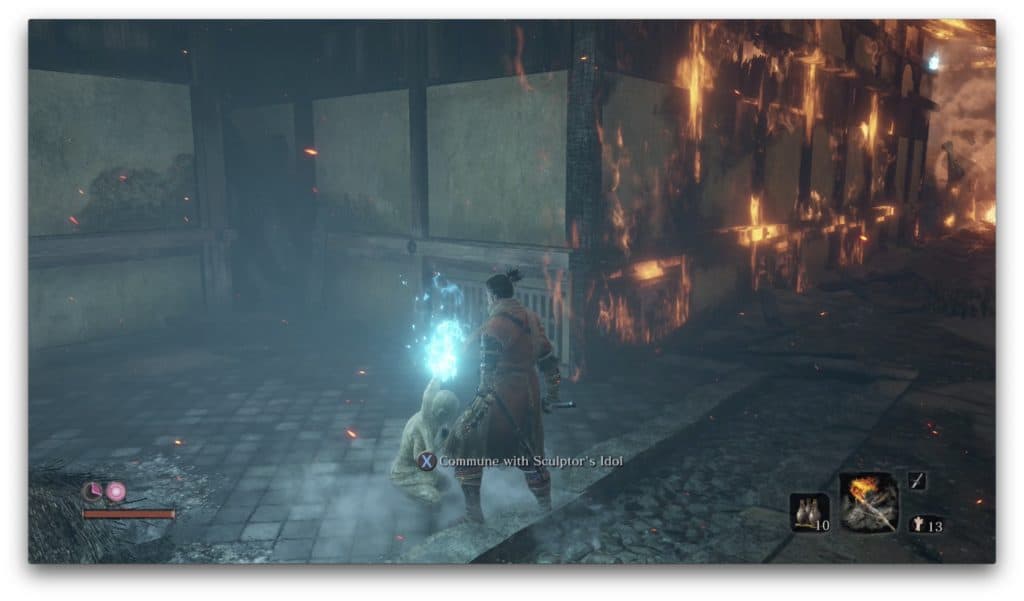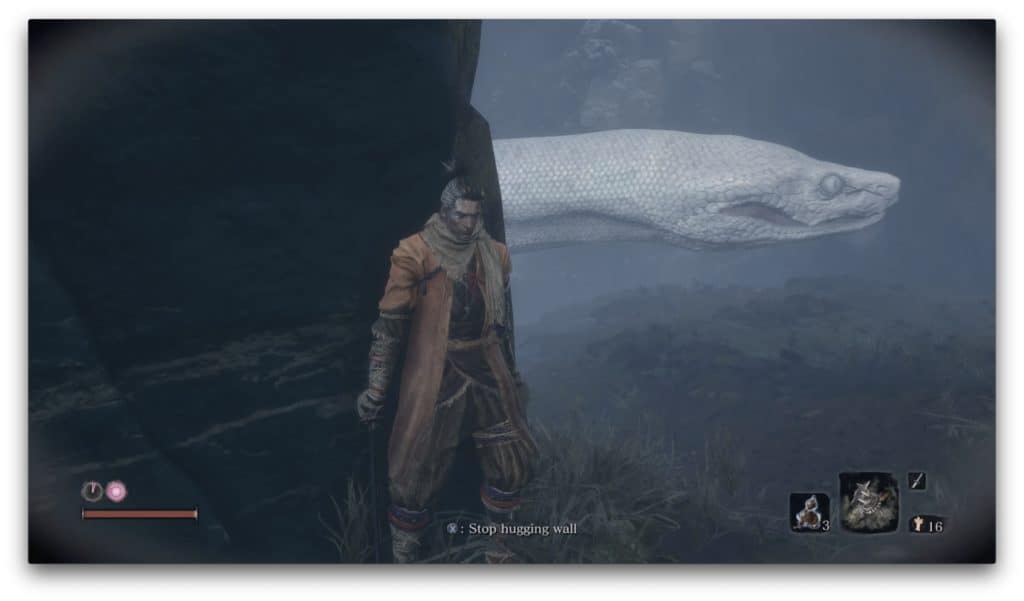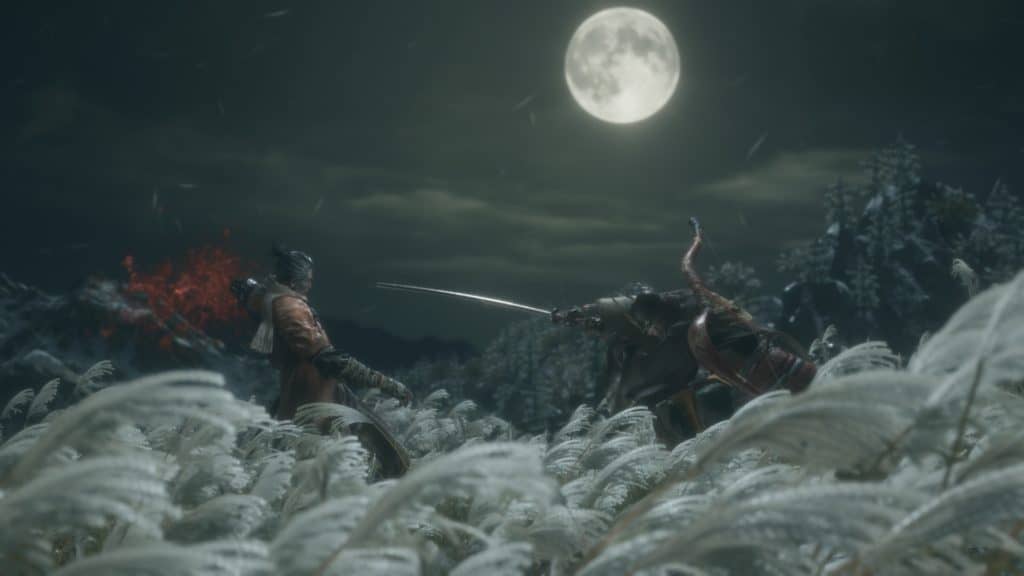When I first heard about Sekiro: Shadows Die Twice, it brought back fond memories of when I first laid my hands on Dark Souls. The original game kicked my butt; over and over again. It beat me into submission and threw me over the edge as I raged, broke controllers, and maybe even a window or two; but that was seven years ago. 2012 was a different time for gaming. For me. I eventually quit the game. Naturally, I went right back a few months later, and in 2013, I learned that the game is not hard, it is challenging. It is not something worth breaking controllers over, as long as you are willing to forgo everything third person action games have taught you in the past. The result? I became good at it.
I became so good at the first game, that I could speedrun and one-shot most bosses that I came across. Then Dark Souls 2 came out. After that, Dark Souls 3. Eventually I played Bloodborne. Wash. Rinse. Repeat. No matter how much they beat me, made me rage, and scream into the void, I always went back to them. Beat them. Over and over again. Showed them how it is done; and I loved every single moment of it. The good news is that the very same repetitive, yet highly rewarding, process is also present in Sekiro: Shadows Die Twice.
Vamers received code for review via From Software on the day the game released. The moment Hans told me about it, I knew that my next challenge had arrived. Although Dark Souls might prepare you for all the deaths and fails by subtitling the game with “Prepare to Die”, Sekiro: Shadows Die Twice features elements of ‘resurrection’. So I scoffed at it. Mocked it. “How can resurrection make things challenging?” I wondered.
Well, I suppose I got the answer handed to me in more ways than I can count. In this Vamers Sekiro: Shadows Die Twice review, I will tell you how the game hit me over the head with a blunt object ad nauseum, and how I loved every second of it.
A ONE-ARMED WOLF.
I LIKE IT!
SEKIRO, THIS IS WHAT I SHALL NAME YOU
From Software’s previous titles, namely Demon Souls, Dark Souls, and even Bloodborne, redefined combat and narrative in ways that I never thought would be possible. Now, Sekiro: Shadows Die Twice takes the best traits of all of those titles and adds elements of its own, while also forcing Soulsborne veterans to forgo everything the previous titles may have taught them. It forces players to stop doing what they did in all of these games, and to learn an entirely new set of moves, combos, and ways of play, while also taking you through an engaging story.
Sekiro: Shadows Die Twice forgoes the usual From Software mantra of letting players and fans “make their own stories” with the little bits of lore they hand you. Instead, it injects players into a new world with a protagonist that existed before the game begins, introduces you to characters with actual backstories, and bosses that are strewn about for actual narrative reasons!
Before we continue, I must mention that this review of Sekiro: Shadows Die Twice is not entirely spoiler-free. While try my damndest to stealth past the biggest twists the game has on offer, I simply cannot speak about certain aspects fo the game without spoiling a few key narrative points that take place within the first ten hours. Please consider yourself warned, dear reader. Mild spoilers on the opening beats of the narrative lie ahead.

Sekiro: Shadows Die Twice takes inspiration from the late 1500 Sengoku-era of Classical Japan. This inspiration dictates the entire look and feel of the game, from characters, setting, and even the story, which focuses on the One Armed Wolf. In this game, players take on the role of this Wolf, a shinobi responsible for protecting Kuro, the last Divine Heir of the Hirata family of the Ashina clan. Kuro is also the last in line of a family blessed with the powers of immortality.
When Wolf wakes up, he learns that a warlord named Genichiro has kidnapped Kuro, and it is now up to the shinobi to get the Divine Heir back. Naturally, this leads to a confrontation between Genichiro and Wolf, where Wolf gets his arm chopped off in spectacular fashion. This directly leads to where the game actually starts, and Wolf learns about his new prosthetic arm. This is also around the time that Wolf learns of his resurrection power, beseeched onto him by The Divine Heir himself.

In stark contrast to the vague and ambiguous narrative style implemented by the studio in its previous games, Sekiro: Shadows Die Twice is focussed specifically on Wolf’s vengeance-filled journey as he makes his way back through Ashina and into the Ashina Castle. He must get his master back at any cost, after all. Given that this is the most narrative a From Software has delivered in decades, it would make sense that your second encounter with Genchiro would be the final match of the game. It is not. No, in fact, this is where the game opens up!
From here on out, it is Wolf’s mission to figure out the past. Three years of missing memories that had been suppressed for some reason, which must now be unveiled. Naturally, because this is a From Software game, players get hints about this as soon as the game allows you to control the shinobi for the first time. It expertly lays down hints that you will only come to appreciate once you have passed a certain key point in the story. This is where From Software’s penchant to hide lore and story beats comes into play.

THICK SHIELDS? BREAK THEM INTO SPLINTERS…
SWIFT FOES? BRING THEM DOWN FROM AFAR.
IF THERE’S SOMEONE THAT NEEDS KILLING, THERE’S A PROPER WAY TO KILL THEM…
Putting the addition of an actual narrative aside, it must be mentioned that this remains a From Software game at heart. As such, this means that the Soulsborne nature of the game will have players die time and again. I know I did. In order to combat this, the game offers a multitude of ways to get by and defeat foes, find secrets, and traverse the world.
Like Demon Souls, Dark Souls 2, 3, and Bloodborne, Sekiro features a hub area where the player can return to at any time to rest, recuperate, upgrade equipment and learn new skills. Similarly, players will find that there are Sculptor’s Idols strewn across the land that will always set them on the correct path. As long as players have communed with a Sculptor’s Idol in a new area, they will always be able to return there. This means that players can use these idols to travel between places at will in Sekiro: Shadows Die Twice.

Occasionally however, players will find themselves back at the hub area, the Dilapidated Temple. For most of the game, the Sculptor will preside inside the temple, where players can upgrade their shinobi prosthetic with new tools. Apart from the default use of the prosthetic (to grapple onto ledges), these tools range wildly in type and function. Early on, you will find the shuriken tool, but as you progress you will start to find secret tools hidden throughout Ashina, find that some merchants carry tools, and even get them as drops from certain bosses.
An optional tool you can get early on, for instance, comes by way of Roberts’ Firecrackers, which the Sculptor will fit onto the prosthetic as the Firecracker tool. This can be used to scare beast-type enemies and blind human enemies for a short while. This is particularly helpful against the blazing bull, or any Samurai General enemies found throughout Ashina. Other, secret tools include the Flame Vent and Loaded Spear, amongst many others.
The addition of the shinobi tools (or Ningu) opens the world to countless possibilities of traversal and enemy slaying. However, as you progress through the story, you will start to notice that some bosses are nigh-impossible to defeat without the correct tool.

Besides the default tools for the prosthetic, From Software also added a brand-new means of progression to the game in the form of skills and prosthetic upgrades. As you kill enemies, you gain experience. Eventually, enough experience will result in a skill point. Skill points, then, can be spent on esoteric texts that you unlock or find as you progress through the game. The Sculptor will give you the first esoteric text when you return to him after gaining a level, while other non-playable characters will also occasionally hand you a block of esoteric texts after you meet certain requirements.
By opening the skills menu, you will find that there are three major skill types that you can unlock. Combat Arts are skills that you need to equip to perform. Latent Skills and Shinobi Arts, on the other hand, are passive skills that will activate in certain conditions, or if the correct buttons are pressed. Latent skills include skills such as the Mikiri Counter, which allows you to counter dangerous thrust attacks by stomping onto enemy weapons. Shinobi Arts, however, are additional combos that add to your arsenal. These include extra slashes at the end of combos, kicks and grabs, and even extra little flourishes that will up the ante for the foes you face in Sekiro: Shadows Die Twice.

Other forms of progression include prayer beads and memories. You will receive a prayer bead for every mini boss that you complete. Once you have four, you can take it to any Sculptor’s Idol in order to increase your vitality and posture. Similarly, every boss you defeat will reward you with a memory of battle. Once presented to an Idol, Wolf will gain an extra attack point. There are other ways to gather prayer beads throughout the game. These can often be found in secret locations, or bought from rare merchants later in the game for a heck of a lot of money.
GOING THROUGH THE FRONT IS NOT AN OPTION…
…LOOK FOR A SIDE ROUTE ALONG THE CLIFFS.
TAKE THE BACK ENTRANCE…
The world of Sekiro: Shadows Die Twice is an enormous, beautiful landscape filled with mountains, forests, and fields. It provides countless areas to explore and tons of incredible vistas to look at. In proper From Software fashion, the world is also linked. Not one area feels like it stands on it own. Played for hours and crossed into a new mountain area? Find a vista and look around — you may just spot an area or two that you have visited long ago. Traversed through what felt like hell, and came out on the other end in a snowy region? Pull out that monocular, and scout a bit. You may find hints of broken bridges you could not traverse earlier in the game. Everything is connected. It is truly amazing.
It is shocking, actually, how much detail From Software injected into the design of the world. Right after I fought a particularly powerful foe, I returned to the same location after the narrative teleported me away, only to find a Sculptor’s Idol. This not only meant that this area had significant value because of the plot, but also that it held an idol – meaning that our sculptor friend who gave us his shinobi prosthetic, has been there before. Similarly, I found another secret area later on in the game, where I could raise or lower a kite. This seemingly innocent thing, later proved essential when I tried to complete a non-playable character (NPC) quest-line.

In this same way, it was easy to attribute cool new meanings to everything I did. For the first time ever in a From Software game, every little thing you do has a narrative purpose. This makes the game and story feel mechanically connected – something very few games can pull off.
The sheer number of explorative locations that you unlock by the time that you enter Ashina Castle is crazy. The world provides a ton of options for players who find themselves stuck on a miniboss, to just go elsewhere and explore a bit more. I remember how a General Samurai boss barred me from moving forward into the castle, so I hopped around and took to the rooftops to get around. I also remember heading out from that area, and into an entirely different one. A wooded area covered in monks who wanted me dead on first sight. That was fun.

However, even as I traversed these areas and kept dying to all sorts of new enemies that I had never seen before, I had one thing in mind: that this was one heck of a beautiful game. Sekiro: Shadows Die Twice takes place during the Sengoku period. As such, you will find that buildings resemble Classical Japanese structures.
Foundations are authentically built with loose rocks, stacked on top of one another by master bricklayers. As such, there are holes of various shapes and sizes in the brick walls. These ports were commonly used by archers and ballistae as strategic little placements that would make it hard for enemy forces to come near. Similarly, you will find that there are multiple wooden gates on the paths leading up to the forts and castles. These were chokepoints – strategic locations that invading forces had to break through, before they could continue onwards toward the forts and castles that they were targeting. The beauty, however, does not stop at the architecture.

Ashina also boasts areas such as Mount Kongo, the Sunken Valley, and even the Hirata Estate, which is unlocked early on in the game. These areas are stunning, in every sense of the word. Kogno boasts beautiful wooded areas, lush with greenery, flowers, and beautiful vistas. The Sunken Valley, on the other hand, is an icy ravine – a valley frozen over – with secret nooks and crannies, and bad guys that hold fancy weaponry that act as both guns and spears. Beyond all of that, you will also find the depths, which hold enemies and bosses such as the headless – tough enemies that require an essential key item that you find during the second half of the game, or consumables such as divine confetti.
The beauty of Sekiro: Shadows Die Twice, however, becomes even more spectacular when you realise that the game does not drop a single frame in any of these locations. It runs like a dream! With that said, I do think that loading could be a bit better. Perhaps From Software will address the long loading in a future patch – the same way they did when people complained about Bloodborne’s atrocious loading. Fortunately, once in-game (and as long as you can stay alive), the loading is kept to a minimum.

YOU TRULY… RETURNED FROM THE DEAD.
THE POWER OF THE DRAGON’S BLOOD.
I NEVER THOUGHT I’D SEE IT WITH MY OWN EYES.
From Software made a huge gamble when they announced that Dark Souls 3 would be the last Souls title. Fortunately, it paid off in a wonderful way. Sekiro: Shadows Die Twice not only boasts an incredible narrative, one which is unlike anything the studio has done before, but it delivers said narrative in an impactful way through gameplay. Where by every little thing you do has been injected with lore and meaning. It is supremely satisfying.
In contrast to other From Software titles, Sekiro: Shadows Die Twice features a proper progression system. Where previous titles relied on new weapons and gear sets to get you by, Sekiro changes it up by allowing players to choose how and when the obtained shinobi tools should be upgraded. This gives the game a role-playing like element, one that directly influences how players interact with the Shinobi Combat Arts, Latent Skills, and Techniques that are unlocked as players progress through the game. As such, players can craft their very own version of Wolf to take on a world of seemingly endless combat opportunities.

These opportunities in Sekiro: Shadows Die Twiceseem limited at first. Then the narrative leads you through to Ashina Castle, and suddenly two other paths open up. Whichever path you choose will open up to even more paths, and so on and so forth! It truly is an incredible experience. Especially when considering how every locale is linked together as part of a single cohesive world. One where you can look back and see areas that you have explored in the past. A gorgeous world with seemingly endless possibilities.
From the endless dying, to the satisfaction you get out of finally obtaining victory. From the beautiful areas and incredibly well-researched architecture, and beyond. From Software have crafted a true masterpiece with Sekiro: Shadows Die Twice. It has an actual story, with real character progression (beyond just upping stats every few pit stops) and super rewarding gameplay. It has everything. It is near-perfection.
| Difficulty | Challenging, but fair (N/A) |
| Time played | 20+ Hours |
| Platform | Xbox One |
| Acquisition | Review code courtesy of Activision |
Junior Editor at Vamers. From Superman to Ironman; Bill Rizer to Sam Fisher and everything in-between, Edward loves it all. He is a Bachelor of Arts student and English Major specialising in Language and Literature. He is an avid writer and casual social networker with a flare for all things tech related.










